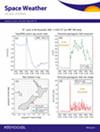Radio Absorption in the Nightside Ionosphere of Mars During Solar Energetic Particle Events
IF 3.7
2区 地球科学
引用次数: 0
Abstract
Characterization, understanding, and prediction of the Martian radio environment are of increasing importance to the forthcoming human exploration of Mars. Here we investigate 3–5 MHz radio absorption in the nightside ionosphere of Mars caused by enhanced ionization at <100 km altitudes during solar energetic particle (SEP) events. We conduct a quantitative analysis of radio absorption and SEP flux data that have been accumulated by two spacecraft currently orbiting Mars, thereby demonstrating that radio absorption is clearly correlated with SEP fluxes. A comparison of the observations with radio absorption properties predicted by a numerical model indicates that the relative temporal changes, radio frequency dependence, and SEP energy dependence of the observed radio absorption are in agreement with the model prediction. Meanwhile, the model systematically overestimates the radio absorption in the ionosphere by a factor of 3.7. We explore several sources of uncertainty, including the electron-neutral collision frequency, absolute sensitivity of the SEP instrument, and limited transport of SEPs to the atmosphere, but the ultimate cause of the systematic discrepancy between the measured and modeled radio absorption is yet to be identified. Further efforts should be put into the development of a comprehensive and observationally validated model of radio absorption in the Martian ionosphere to assist the future crew and spacecraft activities on the surface of Mars.太阳高能粒子事件期间火星夜侧电离层的无线电吸收
火星无线电环境的特征描述、了解和预测对于即将进行的人类火星探测越来越重要。在此,我们研究了太阳高能粒子(SEP)事件期间,火星夜侧电离层中因 100 公里高度电离增强而产生的 3-5 MHz 无线电吸收。我们对目前环绕火星运行的两个航天器积累的无线电吸收和太阳能量粒子通量数据进行了定量分析,从而证明无线电吸收与太阳能量粒子通量明显相关。将观测结果与数值模型预测的射电吸收特性进行比较后发现,观测到的射电吸收的相对时间变化、射电频率依赖性和SEP能量依赖性与模型预测一致。同时,模型系统地高估了电离层的射电吸收,高估了 3.7 倍。我们探讨了不确定性的几个来源,包括电子-中性碰撞频率、SEP 仪器的绝对灵敏度、SEP 对大气的有限传输等,但测量到的无线电吸收与模型的系统性差异的最终原因仍有待确定。应进一步努力开发一个全面的、经过观测验证的火星电离层无线电吸收模型,以帮助未来的乘员和航天器在火星表面开展活动。
本文章由计算机程序翻译,如有差异,请以英文原文为准。
求助全文
约1分钟内获得全文
求助全文

 求助内容:
求助内容: 应助结果提醒方式:
应助结果提醒方式:


